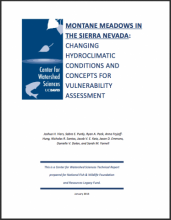Montane Meadows in the Sierra Nevada: Changing Hydroclimatic Conditions and Concepts for Vulnerability Assessment

This technical report provides guidance for resource managers in considering conservation and restoration options for meadow ecosystems considering that the very foundation of meadow ecosystems—the dynamic interplay of surface and ground waters supporting unique vegetation—will likely change in time due to global atmospheric warming and resultant regional hydroclimatic alteration. This report begins by establishing a context for the nature, importance, and organization of montane meadows with a specific focus on a study region inclusive of the Sierra Nevada and portions of the southern Cascade Range (i.e., the upper Pit River complex and portions of the Modoc Plateau). The report then proceeds with an overview of climate change and potential impact to meadows with specific discussion of general trends and projected outcomes, regional differences, and a comprehensive review of potential impacts on hydrological processes. This review is complemented by a discussion of how hydroclimatic alteration may impact meadow dependent species, and which indicator species are likely to be most beneficial for monitoring and management from a conservation standpoint.
Viers, J., S. Purdy, R. Peek, A. Fryjoff-Hung, N. Santos, J. Katz, J. Emmons, D. Dolan, and S. Yarnell. 2013. Montane Meadows in the Sierra Nevada: Changing Hydroclimatic Conditions and Concepts for Vulnerability Assessment. Center for Watershed Sciences, University of California, Davis, Davis, CA.
